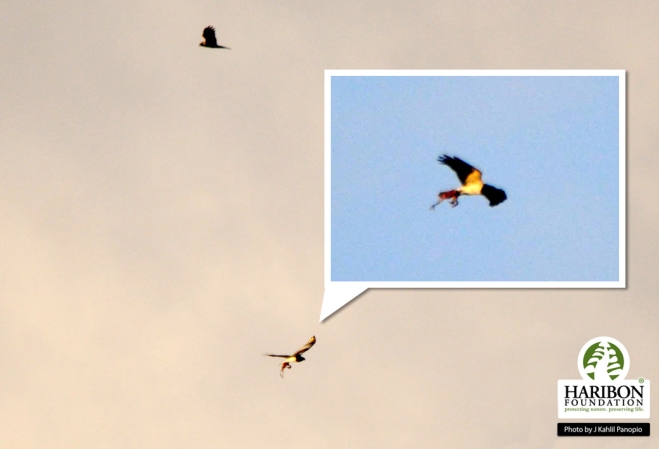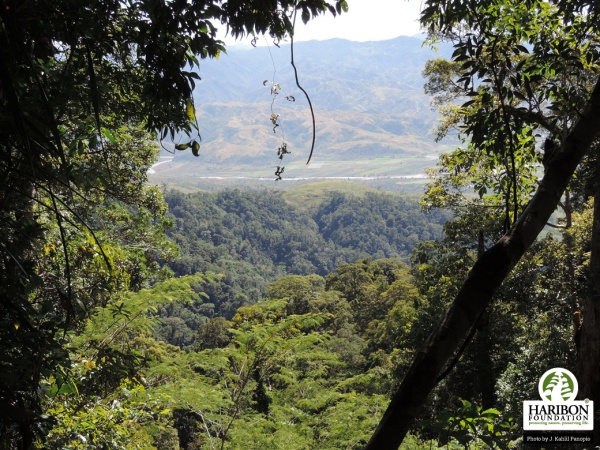It’s not everyday you encounter a species close to extinction.
But, when I first saw the shot below, I didn’t know what I was looking at exactly.
What do you think?

In case you’re unsure of what you’re seeing like I was, that’s a monkey being carried away on its ass by a bird.
More specifically, it shows the critically endangered Philippine Eagle returning from a hunt with a Long Tailed Macaque securely (and awkwardly) in its talons. The photo was taken by conservation biologist Kahlil Panopio from the Haribon Foundation during a research expedition in Nueva Ecija last May 2014.
When I asked Kahlil how he felt after that moment he said:
“I was shaking with excitement when I saw what I had taken a picture of. No one has ever seen it here in over 36 years.”
I found out later that Kahlil had even more reason to have a celebratory shiver because…
The monkey-ass bit isn’t even the most interesting thing about the photograph.
After all, they used to be called Monkey-Eating Eagles.
Turns out, finding a Philippine Eagle in Luzon is already pretty hard to do.
“Their lives, breeding pattern, and feeding habits in Luzon are virtually unknown. Most of what we know about them came from studies in Mindanao. Its scary to think of what knowledge we would’ve lost if someone with a gun spotted it before us.”
Not being a biologist, I wondered how the hell can you tell from a grainy over-cropped picture that it really is a Philippine Eagle?
Thankfully, Kahlil pointed out a number of useful identifiers for us (which I may be paraphrasing here):
- No other predatory birds (known as raptors) found in the area have the balls to feed on anything that size
- The enormous size of the head and beak is unique, along with its white chest, belly, and wings. These are probably used to trick monkeys into thinking that they’re harmless feathery clouds before tearing their flesh apart.
- See photo below

This time, you can clearly see its distinctive markings and even a bit of its face. This was shot taken when they followed it up the mountain.
If you’re still not convinced, it gets better:

That’s a juvenile Philippine Eagle whose stomach I presume is now full of monkey.
It was the third to be spotted by the team after a week into the expedition. Not bad for a previously unstudied location.
Scratch that, it’s absolutely staggering that a whole family was found in the wild, considering their critically endangered status and the sad condition of forests and nature today.
Just so you know (because I didn’t), there’s a chance of practically dying out within 10 years once you’re classified as critically endangered.
Why are they so close to extinction?
Because a pair of Philippine Eagles (and their chick) needs around 100,000 square kilometers of a healthy nurturing environment to survive. That’s 157 times the size of Manila, which isn’t really nourishing anyway.
Sitting on top of the local food chain of bad-assery, the Philippine Eagle is our answer to grizzly bears, great white sharks, and Clint Eastwood. However, this also means that its survival is completely dependent on the ability of the organisms below it to form a functioning ecosystem.
I think I just realized the reason why its local name is Haring Ibon: it literally runs a kingdom.
Actually, they’re more like supervisors: they’re there to keep the lower caste working class population in check.

The problem is, we only have 3% of our primary forests left.
“There might be only be as few as 250 left in the wild. The rapid destruction of forests in the Philippines is driving them to extinction. If we don’t protect the little forest area we have and allow it to grow, then that’s it for them.”
Planting trees helps a lot to prevent that from happening, but as I’ve learned, first make sure you know how to do it the right way, unless you want to do nature more harm than good.

The good news is, this sighting has resulted in the barangay captains, municipal mayors, and the indigenous Dumagat of the surrounding areas implementing rules to guard the mountain from loggers and hunters.
Together with Haribon and the Raptor Conservation Program of the Department of Environment and Natural Resources, these groups are creating a plan on how to utilize the forest – without destroying it in the process.
So what does finding the eagle mean?
The Philippine Eagle is part of our national heritage, but it’s not just being saved for its own sake. Even if it is so damn handsome.
Kahlil sums it up much better than I can:
“If we can keep their habitat healthy, then we’ll also be helping everything else that relies on forests for food, clean air, fresh water, and protection from natural disasters to survive. That includes us people.”
In other words, safe the eagle, save the world. Or the Philippines at least.
Discover what it took Kahlil to capture the photos I used for this post by clicking here to read his day by day account of the original expedition.
Do you think that the Philippine Eagle is still important today?
Bonus: Philippine Eagles kinda look like Nicolas Cage. I’m not kidding. See it for yourself here.
This post was written by volunteer nature lovers. If you think it was helpful, please consider sharing it on Facebook and Twitter to help raise awareness about the Philippine environment. You can also sign up with your email at the bottom of this page so you can be notified when new stories are sent in.
Nice photos! You ftom haribon?
LikeLike
Thanks One Lonely Traveler! But the photos aren’t mine haha. Nope, but Haribon is one of the resources I use when I need to find something out 🙂
LikeLiked by 1 person
Lets save our forest… no to mining..
LikeLike
ok i agree about d good side of spotting d eagles ang posting pictures and stuff. It made us aware of d beauty and true state of d eagles availablty in luzon.
D bad side is, posting this artcle furthr until this gets mainstream would defintly alert all would-be poachers. If this has to be kept a secret, lets keep it that way. For d good and d future of our national bird
LikeLike
I agree with your concern that there might be people with harmful intentions, Dahon. I believe the announcement of the initial discovery was actually put on hold while protective measures were being put in place. This article was cleared for posting by Haribon 🙂
LikeLike
That’s NOT even a Philippine Eagle!!
LikeLike
Hi Igol! What makes you say that?
LikeLike
There is only one giant raptor that is capable of taking/carrying large prey the Philippine eagle, The area should be save and declares as protected area, absolutely NO mining and logging save as a home for our national bird.
LikeLike
There was a few study made by Dr. Robert s. Kennedy about Philippine eagles in Luzon area the eagles primarily feeds on macaques, birds, snakes, fruit bats and giant cloud rats. Flying lemurs are not available or present in Luzon so as the giant cloud rat in Mindanao.
LikeLike
Thanks for reading Alex! I read about Kennedy’s work too (it’s kinda hard not to since he was the first to actually study the Philippine Eagle), but there hasn’t been much follow up research after him. I think he would be proud that Filipinos are continuing what he started 🙂
LikeLike
Hello, I am Kahlil Panopio, a biologist of Haribon Foundation.
For those who are concerned about the welfare of our National Bird in the Mingan Mountains, we are actually pushing for legal protection of the area. Haribon is tying up with the Local Government Units and DENR in Aurora and Nueva Ecija to declare the mountains as a Critical Habitat for the Philippine Eagle. This means no extractive activities, such as Mining and Logging, are allowed inside the Critical Habitat.
You can help us push for the protection of the Mingan Mountains for the Philippine Eagle through raising the environmental awareness level of your colleagues and being a Haribon Member: http://haribon.org.ph/index.php/empowering-people/membership.
You can also support environment conservation organizations by volunteering in activities of Haribon Foundation, World Wildlife Fund, Fauna and Flora International, Conservation International, and many more.
LikeLiked by 1 person
Thanks Kahlil for that wonderful photo (Y) Like you, I wanted the Haring Ibon to live forever in the Philippines ❤
LikeLike
First pic on top…NOT A PHILIPPINE EAGLE!
LikeLike
Looking by the size of the raptor in the photo (bird above photo)
its defenitely a Philippine eagle.
According to the author they were a pair circling above one carrying a monkey and these guys are Biologist they know what they are talking about.
You can check the full article at Haribon Foundation site.
LikeLike
Haribon link: http://www.haribon.org.ph/index.php/feature-articles/323-the-search-for-philippine-eagles-of-the-mingan-mountains
LikeLike
Thanks for replying to this one Alex! When in doubt, ask the biologists.
LikeLike
Did you know that they even tried to change the name of Philippine eagle (foremerly- monkey-eating eagle to “Lemur-eating eagle”) as biologist who study the eagle in Mindanao found out that the eagle’s mainly feed on flying lemurs more than monkeys about 80-90% on some areas. They wanted to uplift the image of the bird from a monkey-eater/destroyer and that monkeys formed only a small proportion to their diet and considered a name change to “lemur-eating eagle” to characterise the specie better, as part of laudable attemps to greater pride in the specie by obtaining a name change, that even Dr. Robert S. Kennedy made much of the fact he found very few monkeys being brought to nests that the “eagle rarely preys on monkeys” however in the very first stomach known to have been examined that pf a male eagle from Camp keithly a monkey was found not yet digested w/c has been dismembered and eaten, starting with the paws then next joints and so on hair an all. Lol! The eagle proved them wrong after all.
LikeLike
hello feelers, i have purchased a plot of land on the east side of negros occidental and there are many trees on the land such as mahogany and palm, can you advise me where i can find a good tree identification book with pictures and text? thanks kenn
LikeLike